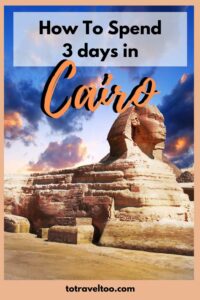If you’re planning a trip to Cairo and have limited time, don’t worry – three days is enough to explore the highlights of this vibrant city. From iconic ancient wonders to bustling markets and delicious cuisine, Cairo offers a rich cultural experience that will leave you awestruck. In this article, we have crafted the perfect Cairo in 3-day itinerary for you, ensuring that you make the most of your time in Egypt’s bustling capital. Get ready to immerse yourself in history, soak up the local atmosphere, and create unforgettable memories in Cairo.
Check out our YouTube Video of our 2 Week Cairo Itinerary
How To Plan a Trip To Cairo – Group Tour, Individual Tour or DIY Tour
One of our frequently asked questions in how many days in Cairo do you need to see the major sites? 3 days in Cairo will enable you to see all the popular sites.
There are three options to plan your Cairo itinerary.
Option One: Join a group tour of Egypt e.g. with Traveltalk
Option Two: Book a private tour for the three days which includes a driver and Egyptologist. This was our preferred way of visiting Cairo and Egypt. We used the services of Egyptian Edu Travel. By using them we could plan our itinerary and stay as long or as short as we wanted on each day. We could start early or late and finish early or late.
We can offer you a 5% discount using Egyptian Edu Travel. Use our promo code TTT2024 and contact email: [email protected]
Option Three: Book individual tours and local transport. Uber is available in Egypt but ensure that payment is through the Uber app and not to pay cash to the driver.
This post may contain affiliate links. Please see our disclosure for more information. As an Amazon Associate, we earn from qualifying purchases (if applicable).
Check out our YouTube Video – Cairo Street Vibe here
3 Days Cairo Itinerary – Summary
Day One in Cairo

Visit the Citadel of Saladin, the Alabaster Mosque of Mohamed Ali and the Egyptian Museum. In the evening visit Cairo Tower.
Day Two in Cairo
Visit the Old Coptic and Islamic Cairo including the Hanging Church, the Holy Family Cave Church, the Ben Ezra Synagogue, Ibn Tulun Mosque, the Gayer Anderson Museum, Khan El Khalili Bazaar and El Moez Street.
Day Three in Cairo
Memphis, Saqqara – the oldest pyramid in the world, GEM (Grand Egyptian Museum) Pyramids of Giza and the Sphinx
We stayed at the Steigenberger El Tahrir Hotel - you can read our review here
Day One Cairo Itinerary
Citadel of Saladin
The Citadel of Saladin is located in the Mokattam Hills area of Islamic Cairo. The Citadel, aka Citadel of the Mountain (Qala’a Al-Jabal), started construction in 1176 by order of Saladin during his reign. Saladin built the Citadel on the highest point in Cairo to protect Cairo against Crusader attacks. He did not see the Citadel finished in 1183 as at that time the current ruler was Al Malek El Kamel.
The Citadel is a popular tourist attraction. The Saladin Citadel contains:
- 4 entrance gates
- 13 towers
- 4 palaces
- 4 Mosques
- 2 Museums which are open to the public – National Police Museum and the National Military Museum
The walls of the Citadel are 30m high and thickness between 10 cm and 15 cm.
Mosque of Mohammed Ali (aka Alabaster Mosque)

Constructed in the mid-19th century (1830 – 1848) in the Ottoman style the Mosque is made up of the great central dome which stands at 52 m high and 21 m in diameter. Two minarets stand on the Western side and rise to 82 metres.
The impressive chandelier was a gift from the French King Louis Philippe the 5th.
The prayer hall is an impressive 1600 sqm. We arrived just as the prayer carpets were being laid out for Friday worship between 12.30 and 1.30 pm.
During your visit, you can see the tomb of King Mohammed Ali made from the finest Italian Carrara marble. He died in 1849 and his body was brought to the Mosque in 1857.
Why is it also known as the Alabaster Mosque? The lower half of the Mosque and the forecourt is made of alabaster whilst the rest of the building is constructed with limestone.
Want the best view of Cairo?
The best view of Cairo can be seen from the Grand Terrace in front of the Mosque. On a clear day, you can see the Giza Pyramids. In front of you and below you can see the Mosque-Madrassa of Sultan Hassan and old Islamic Cairo.
Mosque of an-Nasr Mohammed
The mosque was built in the 14th century and houses two unique minarets shaped like fluted bulbous domes and are made of stone. One minaret called the prayer to the officers and soldiers the other minaret to the Sultan’s Palaces.
Police Museum
Houses uniforms, weapons and small rows of cells that were used until 1983. The assassins of President Sadat were held here in 1981 awaiting their trial. The Museum shows the history of the Egyptian police over the years.
Military Museum
Military exhibits from the Pharaohs to the present times.
Good to know: Journey time from the centre of Cairo to the Citadel is 20 – 25 minutes depending on traffic.
Shoes are to be removed before entering the mosque.
Head scarves for the ladies.
Shoulders and knees to be covered by all.
Opening hours of the Citadel: 9 am to 4.00 pm in winter
Summer 9 am to 5 pm.
We visited on a Friday and it was busy with school students wanting to take selfies with us. Our guide was allowing only a few selfies otherwise we would have been there all day. Fridays are popular for locals to visit.
A UNESCO World Heritage Site since 1976.
Egyptian Museum
The first Egyptian Museum was opened in 1863 but quickly outgrew its premises twice until it relocated to its current location in 1902.
There are two floors with over 170,000 artefacts. If you spent 1 minute looking at each artefact it would take you 3 months.
Good to know: it is hot and quite dusty inside, so wear comfortable walking shoes and take plenty of water.
Open daily from 9 am to 5 pm (last admission 4 pm)
Some of many Highlights that we enjoyed seeing in the Cairo Museum:
3100BC the Narmer Palette – is considered to be the first historical document in the world and contains some very important hieroglyphic inscriptions. Gallery 43 ground floor.

The gold mask of Tutankhamun is located in a small room on the 2nd floor with many other important artefacts from the inner coffin of Tutankhamun. There can be queues to enter and photographs are not allowed. Room 3 upper floor.
The seated statue of King Djoser was found in 1925 in a sealed chamber and it is believed to be the oldest known life-size Egyptian statue. The blue tiles are turquoise from the Sinai and the statue is made from limestone. King Djoser was responsible for the construction of the Step Pyramid of Sakkara. Ground floor.
The Rosetta Stone is a copy in the Cairo Museum. The original is in the British Museum. The Rosetta Stone is famous as it allowed experts to learn how to read hieroglyphs. Three scripts on the stone showed a) the hieroglyphs b) the language of the local people known as demotic and c) Ancient Greek.
Wooden Throne and Sandals of King Tutankhamun
The Golden Wooden Throne 1336 – 1327 BC was made from wood, gold, glass and carnelian.
The sandals are made of leather and are said to be symbolic for the King to tread on his enemies when he wore them.
King Amenophis III and his wife Queen Tyi
The colossal statue of King Amenophis III and his wife Queen Tyi made of limestone and stands 7 m high. The statue was originally standing in Medinet Habu.
Ground floor.
Statue of Mentohotep Nebheptre
Stands 138 cm tall. He was the King who unified Upper and Lower Egypt for the second time after King Narmer.
Ground floor gallery 26.
The Painted Limestone Head of Queen Hatshepsut
From the El-Deir-El Bahari Temple Thebes.
Address: Midan Tahrir
Prepurchase your Entrance Ticket here
(Option pick up and drop off at your hotel if selected when ordering)
Evening Activity in Cairo
Cairo Tower
Standing 615 feet (187 meters) above Cairo, the Cairo Tower’s distinctive latticed structure makes it one of the city’s most visible landmarks, with sweeping views across the city, the Nile, and even the Giza Pyramids. Experience it in comfort and style when you book this private tour, with precise time slots and private hotel transfers so that you can make the most out of your day. Soak up dramatic city views from the Cairo Tower Wide range of time slots lets you plan your day and fit more in Great choice for photographers and as an introduction to the city Take it easy with 2-way private transfers direct from your hotel
Prepurchase your skip-the-line Cairo Tower Ticket and Admission with private transfers here
Dinner Recommendation:
Felfela – 15 Hoda Shaarawy, Bab Al Louq, قسم, Cairo Governorate 4280121, Egypt
Latest reviews: Felfela
Suggested Tours
Day Two Cairo Itinerary

The oldest part of Cairo is now known as Coptic Cairo. Coptic Cairo is home to Egypt’s Christian community.
How to get to Coptic Cairo
You can visit by a tour or with a private driver and guide.
If you are visiting on your own it is recommended to go via the metro. Coptic Cairo has it’s own Metro stop – Mar Girgis.
Opening Hours and Entrance Fees
Coptic Museum – 9 am to 5 pm. 100 EGP for non-Egyptians + 20 EGP for an audio guide (optional)
During Ramadan opening hours for the Coptic Museum is from 9 am to 3 pm.
Coptic Churches – 8 am to 4 pm. Entrance is free.
When to visit the Coptic Cairo area
Our recommendation is to visit first thing in the morning. Expect to see the local Tourism police at the main entrance where you are dropped off. The pedestrian zone starts from the drop-off point, there are a few cafes and souvenir shops here as well.
Babylon Fortress

On your left, as you enter is the impressive Babylon Fortress that was constructed in 100 AD by the Romans on the East Bank of the Nile. It was constructed by Emperor Trajan as a fortress to protect the city of Cairo and to control the trade routes from its canal on the Nile to the Red Sea.
The Hanging Church
Why is it called The Hanging Church? It was built on top of the water gate of the Babylon Fortress. The mosaics on the walls in the garden that lead up to the stairs into the Church are impressive. There are 110 icons in the church.
On our visit, there was a service taking place. Services are held on Wednesday, Friday and Sunday mornings.
It is open daily from 8 am to 4 pm and is free to enter. We recommend to cover your shoulders and knees on entry.
Ben Ezra Synagogue
The Synagogue was originally a church built during the 8th century. The church was destroyed 300 years later and during the 12th century, it was purchased by the rabbi of Jerusalem Abraham Ben Ezra. Over 250,000 documents known as the Geniza documents were uncovered depicting the life of the Jewish community in the 11th and 13th centuries. The church is now funded by the Jewish community from Israel.
Good to know: you are not allowed to take photos of the inside of the church
Cavern Church – Saints Sergius & Bacchus Church
The church is believed to be the oldest in Egypt and also the place where Joseph sheltered here with Mary and Jesus when they escaped persecution from King Herod. Where they rested was 10 metres underground and today it is the crypt which can be reached by stairs by the altar.
We left Coptic Cairo and headed to the Mosque of Ibn Tulun.
Built-in the 9th century the Ibn Tulun Mosque sits on 6.5 acres and has 40 doors. It is one of the oldest Mosques in Egypt and the largest. The rare minaret design has a spiral staircase on its exterior which you can climb. It is worth the climb for the views! The pulpit is also rare made from cedar and ivory from India.
Ibn Tulun was from Iraq and was a son of a slave. He was the founder of the Tulunid Dynasty.
Good to know: shoes are not allowed to be worn. A tip is recommended of 20 LE.
Address: Ahmed Ibn Tolon Sq., Tolon, El Sayeda Zeinab, Cairo Governorate
Opening hours: 8 am to 4 pm
Combined Entrance Ticket: To the Mosque and the Gayer Anderson Museum 60 LE
Gayer Anderson Museum

Gayer Anderson was a British Officer and the private physician to King Farouk serving in Egypt in the 1930s.
The Gayer Anderson Museum is located next to the Ibn Tulun Mosque. The two houses that Gayer Anderson purchased dated back to the 16th and 17th centuries and belonged to wealthy families in Cairo. The Government was going to destroy the buildings before Anderson purchased them. The interiors are full of beautiful antique furniture, carpets and artworks.
Parts of the James Bond Movie – The Spy Who Loved Me was filmed in the Gayer Anderson Museum.
Opening hours: 9 am to 4 pm
Khan El Khalili Bazaar

Cairo’s famous bazaar and souq Khan El Khalili is vibrant, busy, colourful and touristy, but a must if you are visiting Cairo.
If you are not a shopper visit and enjoy coffee in one of the many coffee shops and watch the world go by. You can buy anything you want here, they may be cheaper outside in smaller markets but then you may miss the vibe. Ceramics, water pipes, tea sets, clothing, glassware, spices, jewellery and more.
It was founded in 1382 as the trading hub for Egypt and travellers from around the world. It is a maze and you could easily get lost. Luckily our guide was a regular to the souq, who also knew the best place for coffee and a snack – Oum Kalthoum.
Oum Kalthoum was a famous local singer. The cafe plays her music and is home to memorabilia about her. We enjoyed coffee, mint tea and cake whilst soaking up the vibe of the cafe and the goings on of the bazaar around us.
El Moez Street
The pedestrian street is home to many Islamic Mosques from different areas and was designated a UNESCO World Heritage site in 1979 as part of Old Cairo. Originally El Moez Street was the main street that ran through Old Cairo. Today not only it is home to mosques you can also enjoy a range of shops selling spices, souvenirs, computer parts, lights and more.
It is located next to Khan El Khalili Bazaar.
We enjoyed drinks and entertainment on the rooftop of Saheb El Sahada Restaurant and Cafe.
Address: next to Imam Barquq Mosque in El Moez Street (the street is also known as Al Moez Ldin Allah Street).
Suggested Tours
Day Three Cairo Itinerary
If you want to stay in Giza instead of Cairo we have written a review of our stay at the Marriott Mena House in Giza overlooking the pyramids.
A long day visiting Memphis, Saqqara, the GEM, the Giza and the Sphinx.
Memphis
Memphis is located 20 km south of Cairo, about a 40-minute drive. The Museum is open from 8 am to 4 pm and it is worth getting there as it opens.
Memphis was once the ancient capital of Egypt and dates back to 3100 BC when it was founded by King Menes. The open-air museum at Memphis is located in the village of Mit Rahina. In the gardens surrounding the museum are many statues and objects and the largest is the 18th-century sphinx weighing in at 80 tonnes.

Inside the museum is the 10 m statue of Ramses II lying on its back discovered by the Italian archaeologist Caviglia. The statue is presented lying down as the base and legs from the knees have been broken off.
Estimated viewing time at Memphis: 45 minutes
Sakkara
The driving time from Mit Rahina to Saqqara is 15 minutes. It is located 24 km southwest of Cairo.
Saqqara was developed as the ancient burial ground for Memphis’s Egyptian royalty and is the largest archaeological site within Egypt measuring around 7 km.
Funerary of King Teti
The complex is made up of:
- the pyramid
- the mortuary temple
- ascending passageway
- Valley Temple
It was discovered in 1881 by Gaston Maspero. On entry, he located the burial chamber where he found the hieroglyphic writings known as the ‘pyramid texts’ on the walls.
Tomb of Kagemni

Kagemni was the vizier to King Teti. He held a powerful position overseeing the day-to-day running of the government. Viziers are appointed by the Pharaohs and are the most important people after the King himself. The tomb chambers are decorated with scenes of dancing, hunting and farming and one scene depicts the carriage of the seven sacred oils which were used in rituals.
Serapeum
If you have time it is worth visiting the Serapeum, it should only take approx 20 minutes to walk through the catacombs of the sacred bull Apis. You will marvel at how the sarcophagi, all 25 of them weighing around 70 tonnes each, were constructed. One is still intact the others have been opened and ransacked.
From the reign of Amenhotep III (1390 – 1352 BC), the bulls were mummified as it was seen that they were the incarnation of Ptah, the God of Memphis up until 30 BC.
Step Pyramid of Djoser
The Step Pyramid was constructed 4,700 years ago. In 2650 BC Imhotep, Djoser’s chief architect, was asked to construct the pyramid in stone.
It is the first pyramid to be constructed, before its construction royal burial chambers were underground covered in mud bricks known as mastabas. There are six layers above ground made of stone reaching 60 metres high and there are 3.5 km of tunnels underneath.
Grand Egyptian Museum (GEM)

Our visit to the GEM was a one-hour tour as the GEM has not officially opened as of the beginning of 2024. When it is officially opened you will need to allow at least a couple of hours to visit. You may want to replace your visit to the Cairo Museum with a visit to the GEM.
It will be the largest museum in the world covering over 120 acres, housing 100,00 artefacts. There will be 4,549 items from King Tutankhamun’s tomb. It lies 2 km from the Pyramids of Giza. There will be a hotel and a walkway from the GEM to the Pyramids.
The impressive statue of Ramses II, over 3,200 years old, takes pride of place in the main foyer of the GEM.
Pyramids of Giza

You can’t come to Cairo without visiting the Pyramids of Giza. Such an incredible sight, you may even be able to see them as you fly into Cairo. You will be in awe and wonder how on earth they managed to build the three within 100 years over 4,500 years ago.
It is one of the busiest sites in Cairo and you will need to plan your journey either first thing in the morning or late afternoon. Tourist buses start to arrive before the site opens.
Opening hours April to September 7 am to 6 pm
October to March 8 am to 4 pm.
There is a light and sound show every evening for 55 minutes, in different languages and at different times during winter and summer.
Facts about the Pyramids of Giza
- The Great Pyramid (Pyramid of Khufu) stands 147m high and is made up of 2.3m stone blocks weighing from 2 tonnes to 7 tonnes. It weighs 5.7 million tonnes. It is the oldest of the 3 pyramids. The site is the last of the Seven Wonders of the World and an important UNESCO World Heritage Site. Khufu was the 2nd Pharoah of the 4th Dynasty.
- The second pyramid Khafre stands 143m high. Khafre was the son of Khufu and #4 in the 8 kings of the 4th dynasty.
- The third pyramid of Menkaure stands at 66 m high. Menkaure was the 5th king of the 4th dynasty.
- All three pyramids have been plundered. They were constructed from limestone and granite.
- You can enter the Great Pyramid, it is a separate ticket. There is not much to see compared to other sites with their colourful artwork and interiors. If it is the only Pyramid you plan to enter on your visit then purchase the ticket. You will experience going up and down steep staircases and low passageways. If you are claustrophobic you may want to consider.
- You can enter the other two – they rotate daily. Khafre is cheaper to enter and you will find it is busier than Khufu’s.
Good to know: We found that If you are with a guide you are less hassled around the Pyramids and elsewhere that we visited during our 3 days.
The Sphinx

The Sphinx stands guard down the hill from the Pyramid of Khafre. The Sphinx dates back over 2500 BC and stands 20 m tall. It is 73 m in length and 6 m wide.
The Sphinx faces to the east and has the body of an animal and the head of a Pharoah.
Suggested Tours
More Tours Around Cairo
Want to add Alexandria to your itinerary?
2 Days in Alexandria Egypt ItineraryGeneral Travel Information for Visiting Cairo
Flights to Cairo
There are flights available to Cairo from major cities around the world.
Internal flights are recommended to be booked in advance.
For the latest flight deals click here
Hotel Accommodation
During our time in Cairo, we stayed at the Steigenberger Hotel on El Tahir Square and for our time in Giza we transferred to the Marriott Mena House in Giza.
You can read our review of the Steigenberger El Tahrir Hotel Cairo here
For more hotel accommodations click here
You can see our YouTube videos here (review articles to follow).
Airport Transfers
Sim Cards
This time we trialled the Holafly e-sim card and also purchased a Vodafone sim card at the airport.
The e-sim card had great coverage even when travelling through the desert from Aswan to Abu Simbel. The issue for us with e-sims is that we cannot hotspot to our laptops or access Facebook Messenger. The sim card purchased at the airport had good coverage and could hotspot and access Messenger.
Visas
There are two ways of obtaining Egyptian visas – online and on arrival.
We purchased our Egyptian visas online through the Egyptian Government portal.
The fee was USD25 and took two days. You will need to check your entry requirements depending on what passport you hold.
Travel Insurance
World Nomads offers simple and flexible travel insurance. Buy at home or while travelling and claim online from anywhere in the world.
To Travel Too Travel Shop
Travel smarter and safer with products from our To Travel Too Travel Shop. If you are looking for the latest luggage, guidebooks or travel accessories we have you covered with over 800 travel products to choose from.
Where to next?
Are you on Pinterest? We are at To Travel Too and we have many travel-related boards check us out at Pinterest. If you enjoyed our article why not pin it to your board and read it later?



In conclusion, experiencing Cairo in just three days is an exhilarating adventure that offers a taste of the city’s rich history, vibrant culture, and iconic landmarks. From exploring ancient wonders like the Pyramids of Giza and the Egyptian Museum to immersing oneself in the bustling streets of Khan el-Khalili market and savouring traditional cuisine, Cairo has something to offer every traveller. While three days may not be enough to fully uncover all that this magnificent city has to offer, it is certainly sufficient to leave visitors awe-inspired and craving for more. With its captivating blend of old-world charm and modern marvels, Cairo stands as a testament to Egypt’s rich heritage and should undoubtedly be on every traveller’s bucket list.








Leave a reply